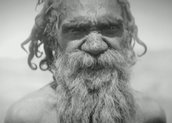


First Australians – Episode 4, No Other Law (2008)
Synopsis
Episode four, 'No other law’, explores the history of white settlement in Central Australia and the stories of homicidal police officer Constable Willshire, who brings mayhem to the Arrernte nation. Authorities turn a blind eye before telegraph operator Frank Gillen stops him.
Curator’s notes
The first contact between Aboriginal people and white settlers in the central desert was experienced more than 100 years after first contact on the east coast of Australia. What followed is typical of the treatment of Indigenous people from the late 19th century right up to the 1960s. That is, the decimation of Aboriginal culture through religion and institutionalisation, and sometimes outright murder with little or no legal consequences for the perpetrators.
All the while, a record of this ‘dying race’ was being preserved for posterity. As a result of Charles Darwin’s theory of evolution and survival of the fittest, it was a popular belief at the time that Aboriginal people would soon die off because of the presence of a more superior race, Caucasian Europeans (see First Australians – Episode 2, Her Will to Survive).
The episode begins with a disclaimer: ‘This film has been carefully checked by Senior Arrernte Men. Women and children can see all of the photographs and hear the music, stories and ceremony that appear in the following program.’ This statement is a testament to the restricted nature of cultures like that of the Arrernte, an ancient, ongoing culture with complex systems and strict laws to be adhered to. Transgressions of these laws and systems bring severe consequences, as seen in this episode.
White settlers and missionaries were a destructive force on the Aboriginal culture of Central Australia, as they ignored and even tried to erase the sacred laws of the people. Pastoralists were equally devastating as they traipsed across the country and desecrated sacred sites with their livestock. Arrernte creation stories at the opening of the episode explain why the land itself is so sacred that ‘the landscape is the ancestors and their eternal presence makes the land sacred’ (see clip one). Explanations of their belief system and its importance in Arrernte life brings into perspective the seriousness of offences committed against Aboriginal people during white settlement. Imagine the response today to a farmer bringing his cows into a church or other place of worship?
Such transgressions against their sacred culture, combined with the Arrernte’s poaching of livestock, escalated conflict in the area and the police presence was raised dramatically. Policemen like Constable William Willshire forced convicted cattle killers to become native police or else be imprisoned. Native police were unfortunately commonplace in frontier zones and placed recruits in a difficult position: they were torn between two worlds, forcing brother against brother. The Tracker (2002) dramatises the destructive nature of native police forces at this time in history.
The interpretation of Willshire’s writings reveals his sinister character as he describes the pleasures to be found in the Aboriginal women and children on the frontier. His indiscretions eventually led to the first South Australian trial of a police officer for murder of a black man, but he was found not guilty. The racism of South Australia’s judicial system is still acutely evident many years later, as seen in the film Black and White (2002) about the 1958 trial of Max Stuart, who coincidentally appears in this episode as an interviewee.
The man who gave the primary evidence against Willshire, Francis Gillen, worked on the overland telegraph line and grew to appreciate the unique Arrernte culture he encountered. He and Baldwin Spencer, an anthropologist from Melbourne, controversially collected secret-sacred emblems (churinga) and filmed secret-sacred ceremonies. It was a common but misguided practice of the time and such collections are now subject to repatriation requests from Indigenous groups. The open footage such as the 1901 Tijingalla ceremony and the tome The Native Tribes of Central Australia (1899) have given us an invaluable understanding of Arrernte culture and kept it safe for their children and their children’s children.
Today, the Baldwin Spencer collection is held at Museum Victoria which, in partnership with the National Film and Sound Archive, has repatriated open segments of the footage to Aboriginal communities in the Northern Territory.
This episode was first broadcast on SBS on Tuesday 21 October 2008.
- Overview
- Curator’s notes
- Video 3 clips
- Principal credits
- Find a copy
- Make a comment
- Map
- Add your review



